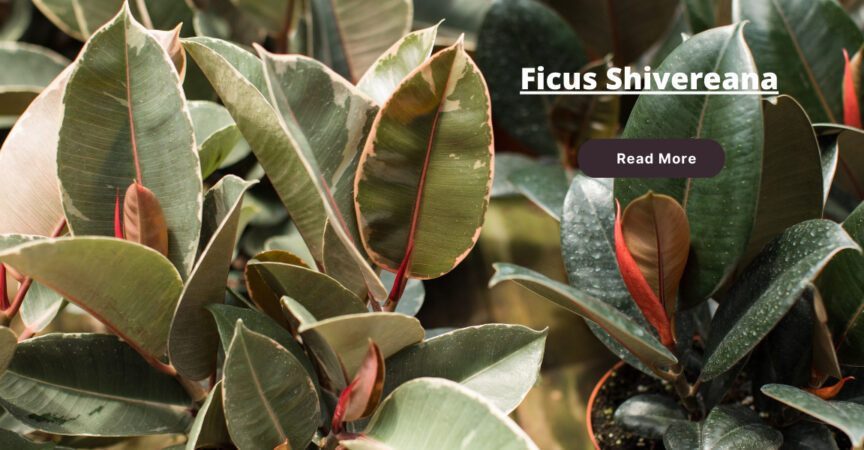Ficus Shivereana: Care Tips, Plant, Propagation ⏬👇
Ficus Shivereana, a charming member of the Ficus family, has gained popularity among indoor plant enthusiasts for its distinct and eye-catching foliage. Its elegant appearance and low-maintenance nature make it a favorite choice for those looking to enhance the beauty of their indoor spaces with a touch of nature.
Ficus Shivereana Care
Ficus Shivereana, also known as the Variegated Rubber Plant, is a popular indoor plant known for its attractive foliage. Here’s a brief care guide to help you keep your Ficus Shivereana healthy and thriving:
Light:
- Place your Ficus Shivereana in bright, indirect light. Avoid direct sunlight, as it can scorch the leaves.
- This plant can tolerate lower light conditions, but its growth may slow down.
Temperature:
- Maintain a consistent room temperature between 65-75°F (18-24°C).
- Avoid exposing the plant to cold drafts or sudden temperature fluctuations.
Watering:
- Water the plant when the top inch (2.5 cm) of the soil feels dry to the touch.
- Water thoroughly, allowing excess water to drain from the pot. Ensure the pot has drainage holes.
- Reduce watering during the winter months when the plant’s growth slows down.
Humidity:
- Ficus Shivereana appreciates moderate humidity. You can increase humidity by misting the leaves or using a humidity tray.
- In dry indoor environments, consider using a room humidifier to maintain adequate moisture levels.
Soil:
- Use a well-draining, peat-based potting mix for your Ficus Shivereana.
- Repot the plant every 2-3 years or when it becomes root-bound.
Fertilization:
- Feed your plant during the growing season (spring and summer) with a balanced liquid fertilizer every 2-4 weeks.
- Reduce or eliminate fertilization in the fall and winter when the plant’s growth slows down.
Pruning:
- Prune to maintain the desired shape and remove any dead or yellowing leaves.
- Wear gloves when handling the plant, as the sap can be irritating to the skin.
Pests and Diseases:
- Keep an eye out for common houseplant pests like spider mites and mealybugs. Treat infestations promptly with insecticidal soap.
- Ensure good air circulation to prevent fungal issues.
Propagation:
- Ficus Shivereana can be propagated through stem cuttings. Take a cutting with at least one leaf node, allow it to callus, and then plant it in a well-draining mix.
- Propagation is best done in the spring or early summer.
Caution:
- Ficus Shivereana is toxic if ingested, so keep it out of reach of pets and children.
By following these care guidelines, you can enjoy the beauty of your Ficus Shivereana and watch it thrive in your indoor space. Remember that each plant is unique, so adjust care as needed based on your specific plant’s requirements.
Ficus Shivereana Plant
Ficus Shivereana, commonly known as the Variegated Rubber Plant or Variegated Indian Rubber Tree, is a stunning indoor plant prized for its attractive foliage. Here’s a concise overview of this plant:
Appearance:
- Ficus Shivereana is recognized for its distinctive variegated leaves. These leaves are typically oval-shaped and come in shades of dark green with creamy white or yellowish-white marbling.
- The plant’s leaves have a glossy sheen, adding to its aesthetic appeal.
Size:
- When grown as a houseplant, Ficus Shivereana typically reaches a height of 2 to 6 feet (0.6 to 1.8 meters). Its size can be managed through pruning.
Light Requirements:
- This plant thrives in bright, indirect light. Avoid exposing it to direct sunlight, as this can lead to leaf burn.
- It can adapt to lower light conditions but may grow more slowly.
Watering:
- Water the Ficus Shivereana when the top inch (2.5 cm) of soil feels dry to the touch. Ensure that the pot has drainage holes to prevent overwatering.
- Reduce watering frequency during the dormant winter months.
Temperature and Humidity:
- Maintain a consistent room temperature between 65-75°F (18-24°C). Avoid sudden temperature fluctuations and drafts.
- Ficus Shivereana appreciates moderate humidity levels. You can increase humidity by misting the plant or using a humidity tray.
Soil:
- Use a well-draining, peat-based potting mix to plant your Ficus Shivereana.
- Repot the plant every 2-3 years or when it becomes root-bound.
Fertilization:
- During the growing season (spring and summer), feed the plant with a balanced liquid fertilizer every 2-4 weeks. Reduce or eliminate fertilization in the fall and winter.
Pruning:
- Prune your Ficus Shivereana to maintain its shape and remove any dead or yellowing leaves. Wear gloves when handling, as the sap can be irritating to the skin.
Propagation:
- You can propagate Ficus Shivereana through stem cuttings. Take a cutting with at least one leaf node, allow it to callus, and then plant it in a well-draining mix.
- Propagation is most successful during the spring or early summer.
Pests and Diseases:
- Watch for common houseplant pests such as spider mites and mealybugs. Treat infestations promptly with insecticidal soap.
- Good air circulation can help prevent fungal issues.
Caution:
- Ficus Shivereana is toxic if ingested, so keep it out of reach of pets and children.
The Ficus Shivereana plant is an excellent choice for adding a touch of elegance to your indoor space, thanks to its striking variegated foliage. With proper care, it can thrive and beautify your home or office environment.
Ficus Shivereana Propagation
Propagating Ficus Shivereana, also known as the Variegated Rubber Plant or Variegated Indian Rubber Tree, can be a rewarding way to expand your plant collection or share this beautiful plant with others. Here’s a concise guide on how to propagate Ficus Shivereana:
Propagation Methods:
- Stem Cuttings:
- Stem cuttings are the most common method for propagating Ficus Shivereana.
- Select a healthy stem with at least one leaf node. Leaf nodes are the small bumps on the stem where leaves and roots grow.
- Use a clean, sharp knife or scissors to cut a 4-6 inch (10-15 cm) section of the stem just below a leaf node.
- Allow the cut end to air dry for a few hours to form a callus. This helps prevent rotting.
- Plant the cutting in a well-draining potting mix, burying the node and leaving at least one leaf above the soil.
- Water the cutting lightly and cover it with a plastic bag or a propagation dome to create a humid environment.
- Place the cutting in bright, indirect light.
- Keep the soil consistently moist but not waterlogged.
- Roots should develop in 4-6 weeks, and you can transplant the new plant into a larger pot once it has grown a few inches.
- Water Propagation:
- This method involves placing the stem cutting in a container of water to encourage root growth before transferring it to soil.
- Follow the same steps as for stem cuttings, but instead of planting the cutting in soil, place it in a container of water.
- Change the water regularly to prevent stagnation and the development of algae.
- Once the cutting has grown roots that are a few inches long, transfer it to a pot with well-draining soil.
- Air Layering:
- Air layering is a more advanced method that involves creating roots while the stem is still attached to the parent plant.
- Select a section of the stem where you want to encourage root growth.
- Make a small, upward diagonal cut into the stem and insert a toothpick or a small piece of wood to hold the wound open.
- Apply rooting hormone to the exposed area.
- Wrap a moistened sphagnum moss ball around the wounded area and cover it with plastic wrap or aluminum foil to create a humid environment.
- Roots should develop in a few weeks to a few months.
- Once roots are well-established, you can cut the stem below the rooted section and plant it in its own pot.
Propagation Tips:
- Propagation is most successful during the growing season, which is typically in the spring or early summer.
- Ensure your tools and containers are clean and sterile to prevent disease.
- Maintain a consistent, warm temperature and provide bright, indirect light for your propagating cuttings or air layers.
With the right care and attention, propagating Ficus Shivereana can be a successful and enjoyable way to create new plants and share their beauty with others.
Ficus Shivereana indoor Plant
Ficus Shivereana, also known as the Variegated Rubber Plant or Variegated Indian Rubber Tree, is a striking indoor plant that can elevate the aesthetics of any home. Here’s a brief overview of this captivating indoor greenery:
Appearance:
- Ficus Shivereana is admired for its glossy, variegated leaves. Each leaf features a beautiful blend of dark green and creamy white patterns, creating an eye-catching display of natural artistry.
- The leaves are typically oval or elliptical in shape and can grow up to 6 inches (15 cm) long.
Care and Maintenance:
- Light Requirements: Place your Ficus Shivereana in bright, indirect light. It thrives in filtered sunlight but should be protected from harsh, direct sunlight, which can scorch its leaves.
- Temperature: Maintain a warm and consistent indoor temperature. Avoid exposing the plant to cold drafts or sudden temperature fluctuations.
- Watering: Allow the top inch (2.5 cm) of the soil to dry out between waterings. Water sparingly during the winter months when growth slows down.
- Humidity: Ficus Shivereana appreciates higher humidity levels. You can achieve this by misting the plant regularly or placing it on a humidity tray.
- Soil: Plant your Ficus Shivereana in a well-draining potting mix to prevent waterlogging, which can lead to root rot.
- Pruning: Prune the plant to maintain its shape and remove any damaged or yellowing leaves.
- Fertilizing: Feed your Ficus Shivereana with a balanced liquid fertilizer during the growing season (spring and summer) every 4-6 weeks.
Benefits:
- Air Purification: Like many other ficus varieties, Ficus Shivereana is an excellent air purifier. It helps remove indoor pollutants and enhances air quality.
- Aesthetic Appeal: Its variegated foliage adds a touch of elegance and natural beauty to your indoor space.
- Low Maintenance: With proper care, Ficus Shivereana is relatively low-maintenance and forgiving of occasional lapses in care.
Caution:
- Keep in mind that Ficus Shivereana, like other ficus plants, is toxic to pets if ingested. Ensure it’s placed out of reach of curious pets.
Ficus Shivereana is not only a visually appealing houseplant but also a wonderful addition to your indoor garden that can thrive with a bit of attention and care. Its striking foliage is sure to make it a focal point in any room.
Ficus Shivereana Care Tips
Ficus Shivereana, also known as the Variegated Rubber Plant, is a stunning indoor plant known for its attractive variegated leaves. To ensure your Ficus Shivereana thrives, follow these care tips:
1. Light Requirements:
- Place your Ficus Shivereana in bright, indirect light. It enjoys filtered sunlight but should be shielded from direct sun to prevent leaf scorching.
2. Temperature:
- Maintain a consistent indoor temperature between 65-75°F (18-24°C). Avoid exposing it to cold drafts or sudden temperature changes.
3. Watering:
- Allow the top inch (2.5 cm) of the soil to dry out before watering. Water sparingly during the winter months when growth slows down.
4. Humidity:
- Ficus Shivereana prefers higher humidity levels. Increase humidity by misting the plant or placing it on a humidity tray.
5. Soil:
- Use well-draining potting soil to prevent waterlogged roots. A mix designed for tropical plants works well.
6. Pruning:
- Regularly prune to maintain its shape and remove yellowing or damaged leaves.
7. Fertilizing:
- Feed your Ficus Shivereana with a balanced liquid fertilizer during the growing season (spring and summer) every 4-6 weeks.
8. Potting:
- Repot your Ficus Shivereana every 2-3 years or when it outgrows its pot. Choose a slightly larger container.
9. Pests and Diseases:
- Keep an eye out for common houseplant pests like spider mites and scale insects. Treat any infestations promptly.
- Proper watering and avoiding over-fertilization can help prevent root rot.
10. Caution:
- Ficus Shivereana is toxic if ingested by pets or humans. Keep it out of reach of curious pets and children.
By following these care tips, you can enjoy the beauty of your Ficus Shivereana while ensuring it remains a healthy and vibrant addition to your indoor space.
Email Bülteni
Yeni yazılarımızdan hemen haberdar olmak için kayıt olun.







